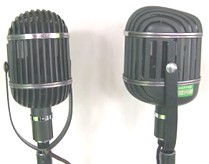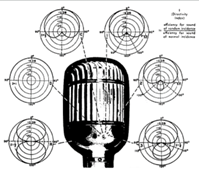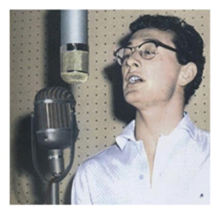The Western Birdcage Revolutionizes Audio

[September 2024] Some parts of broadcasting have not changed since its very beginnings. People do not talk in digital fashion – we have always been analog. Getting the best quality reproduction of voice and music has been a top priority of microphone designers. Dave Felice shares with us the background of one of the finest models ever produced.
It is one of the most famous products bearing the Western Electric name.
Anyone who has listened to recorded music or broadcasting since the 1940s has likely heard the sound produced by the legendary Western Electric 639A/B “birdcage” microphone.

A 639 sales brochure touted the microphone’s performance: “Here is a microphone that brings a new concept of quality, performance, and universality ─ a microphone that sets new high standards of efficiency, convenience, appearance, and functional control.”
A NEW DESIGN
By 1935, the audio division of Bell Labs had already achieved success with the Model 630 omni-directional dynamic microphone known as the Eight Ball because of its round head shape.
The development of higher quality microphones fit with the Bell System’s continuous interest in carrying voice, both on wired phone systems and broadcasting. Up to this point, Western actually had not made a ribbon microphone, although Bell Labs invented the dynamic microphone design.
The advance of both relied on electronic amplification, through the three-element Audion triode vacuum tube invented by Dr. Lee de Forest as early as 1906. After graduating from Yale, de Forest’s first job was at Western Electric in Chicago, where he developed his first radio receiver. (Sometimes de Forest is called “the Father of Radio,” as his development of amplification circuitry was crucial to broadcasting, as well as long distance telephony, motion picture sound, and countless other applications.)
MULTIPLE PATTERNS
In the subsequent design of the 639A/B, the company hoped to develop a new multi-pattern design to compete with the popular capsule-shaped RCA DX77 and angular BX44 series, without infringing on RCA patents.
Introduced in 1938, the 639A provided three selectable pick-up patterns, featuring a unique combination of dynamic and ribbon microphones and windscreen, in one shell.
The 639B expanded the choice of patterns to six.
The elements ─ dynamic moving coil or ribbon velocity actuated ─ could be used independently or combined by a selector switch at the base. Frequency response in any position was 40 KHz to 10 KHz – a respectable rating even today.

A low output impedance of 30 to 50 Ohms enabled the 639 microphones to be used far away from amplifiers without increased noise, hum, or signal deterioration.
An internal transformer provided amplification and impedance matching for the velocity ribbon section. The directional characteristics made the 639A/B an outstanding choice for clear and separate pick up of multiple distinct sources, a highly attractive feature for covering a large space, such as orchestras and dance music bands.
A POPULAR CHOICE
The 639A/Bs are large, measuring five-and-a-half inches high by about six inches around with a weight to match the size.
Even so the microphones became immediately popular in just about any application, from studio recording to congressional hearings. The 639 microphones were also used at the United Nations assemblies. Photographs of radio performers of the time often show the 639 microphones.

Broadcasters liked the “bright” reproduction of lower (bass) tones. The microphones were still in use in the Denver area as late as the 1980s. They are still in high demand today, sometimes selling for thousands of dollars.
At left, Buddy Holly with 639A and Newmann U47 microphones at Norman Petty’s studio in Clovis, New Mexico.
SOME WESTERN ELECTRIC HISTORY
The 639 was not the first product Western Electric brought to market.
Founded in Chicago in 1869, Western Electric was acquired by the Bell Telephone Company in 1881. Not only did that end a major patent fight over the telephone, but the merged companies were then in a position to standardize telephone manufacturing – and more.
According to company records, in 1921, Western Electric produced Model 1-A, which was the first factory-built broadcast transmitter. Other products include consoles and, of course, microphones.
In 1928, the Western Electric Division formed Electric Research Products, Inc. (ERPI), to manufacture, install, and service talking picture systems in studios and theatres. By 1936, Western Electric had divested ERPI. Management then formed the “All Technical Services” Company, or Altec Services Company, to continue service contracts and manufacture some theatre sound equipment.
ALTEC MEETS LANSING
In 1941, Altec Service Company bought nearly bankrupt Lansing Manufacturing Company, and formed Altec Lansing Corporation.
By the way, one of the founders, James B. Lansing, left to form his audio products company known as JBL. So, both Altec Lansing and JBL share the Western Electric heritage with only a few degrees of separation.
In early 1941, William Harry and Robert Marshall of Bell Laboratories got a design patent for the 639.
“GOODBYE” TO WESTERN ELECTRIC

In accordance with a federal anti-monopoly order, Western Electric spun off its audio business to become Altec in October 1949.
(Altec operated as a US company. However, there was a Canadian Division, known as Northern Electric, now Nortel, which produced consoles and other gear for the Canadian market.
Other than the name, the Altec and WE 639 microphones are identical as were many of the other products such as audio consoles.
Through corporate restructuring and mergers over nearly 100 years, Altec Lancing continues to produce highly-regarded consumer and professional equipment, particularly speakers.

– – –
Among the resources used to develop this material, we wish acknowledge contributions from retired broadcast engineer Don Bishop.
– – –

https://www.nautel.com/products/fm-transmitters/lpfm/
– – –
Dave Felice actually used a 639A with a WE 23A console from 1969-71. After starting at his (school) carrier current station Felice specialized in all news programming, working at stations in Colorado, Nevada, Nebraska and Utah. Later, he was at “the phone company,” until retiring in 2017. You can contact Dave at gelato321@aol.com
– – –
Would you like to know when more articles like this are published? It will take only 30 seconds to
click here and add your name to our secure one-time-a-week Newsletter list.
Your address is never given out to anyone.
